ECON 214 Problem Set 6: Impact of Monetary Policy Changes
VerifiedAdded on 2023/06/12
|6
|913
|378
Homework Assignment
AI Summary
This economics assignment delves into the effects of monetary policy on real economic factors, particularly focusing on the short-run impacts of changes in the money supply. It addresses the relationship between printing money and altering real income, the preference for stable inflation rates, and the distinction between active and passive monetary policies. Using the aggregate supply-aggregate demand model, the assignment illustrates the short-run effects of both decreases and increases in the money supply on real GDP, price levels, and unemployment rates, starting from a long-run equilibrium. The analysis includes graphical representations showing shifts in aggregate demand and short-run aggregate supply curves, ultimately demonstrating how these policies influence macroeconomic variables. Desklib provides this solution, along with numerous other resources, to aid students in their academic pursuits.
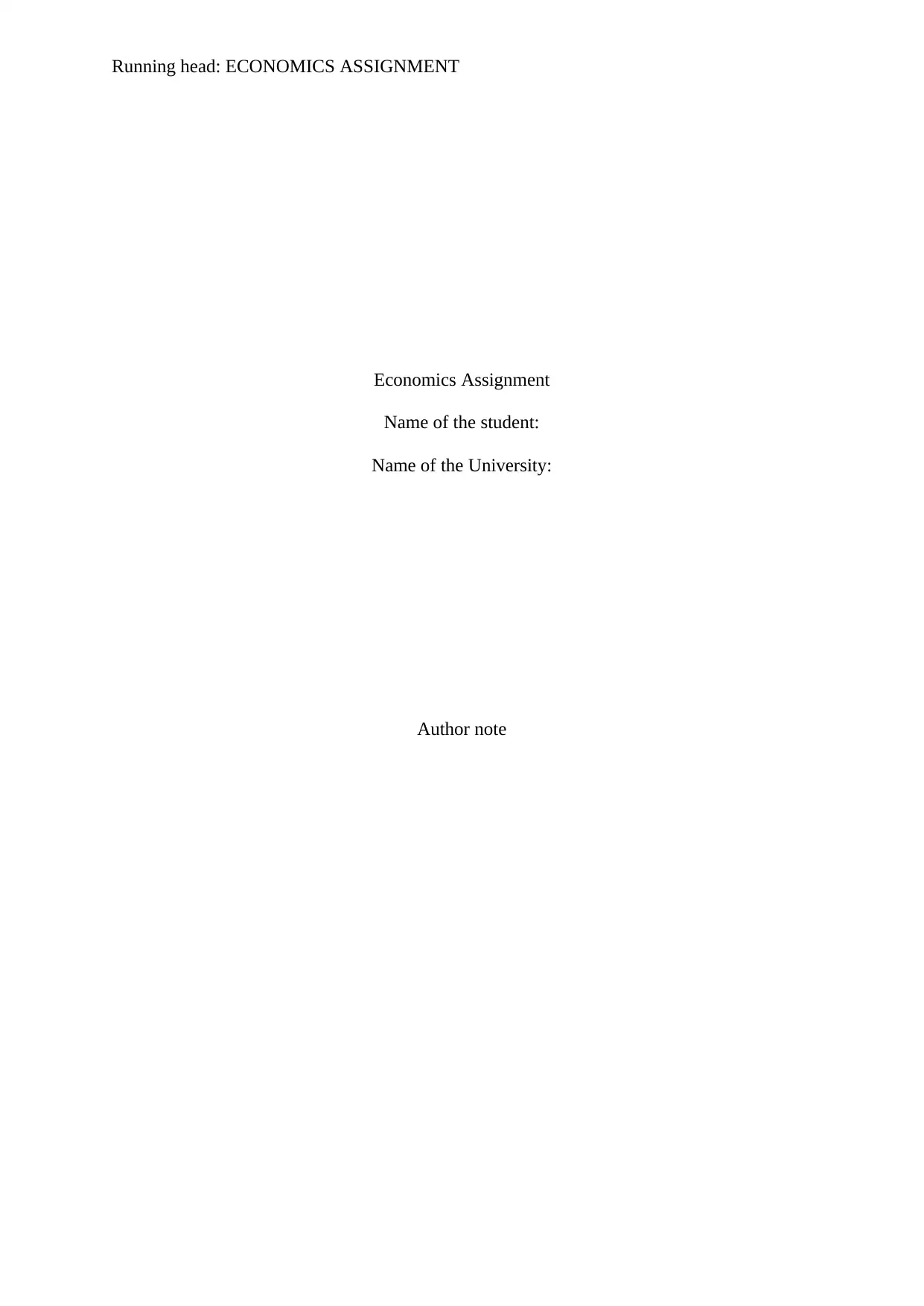
Running head: ECONOMICS ASSIGNMENT
Economics Assignment
Name of the student:
Name of the University:
Author note
Economics Assignment
Name of the student:
Name of the University:
Author note
Paraphrase This Document
Need a fresh take? Get an instant paraphrase of this document with our AI Paraphraser
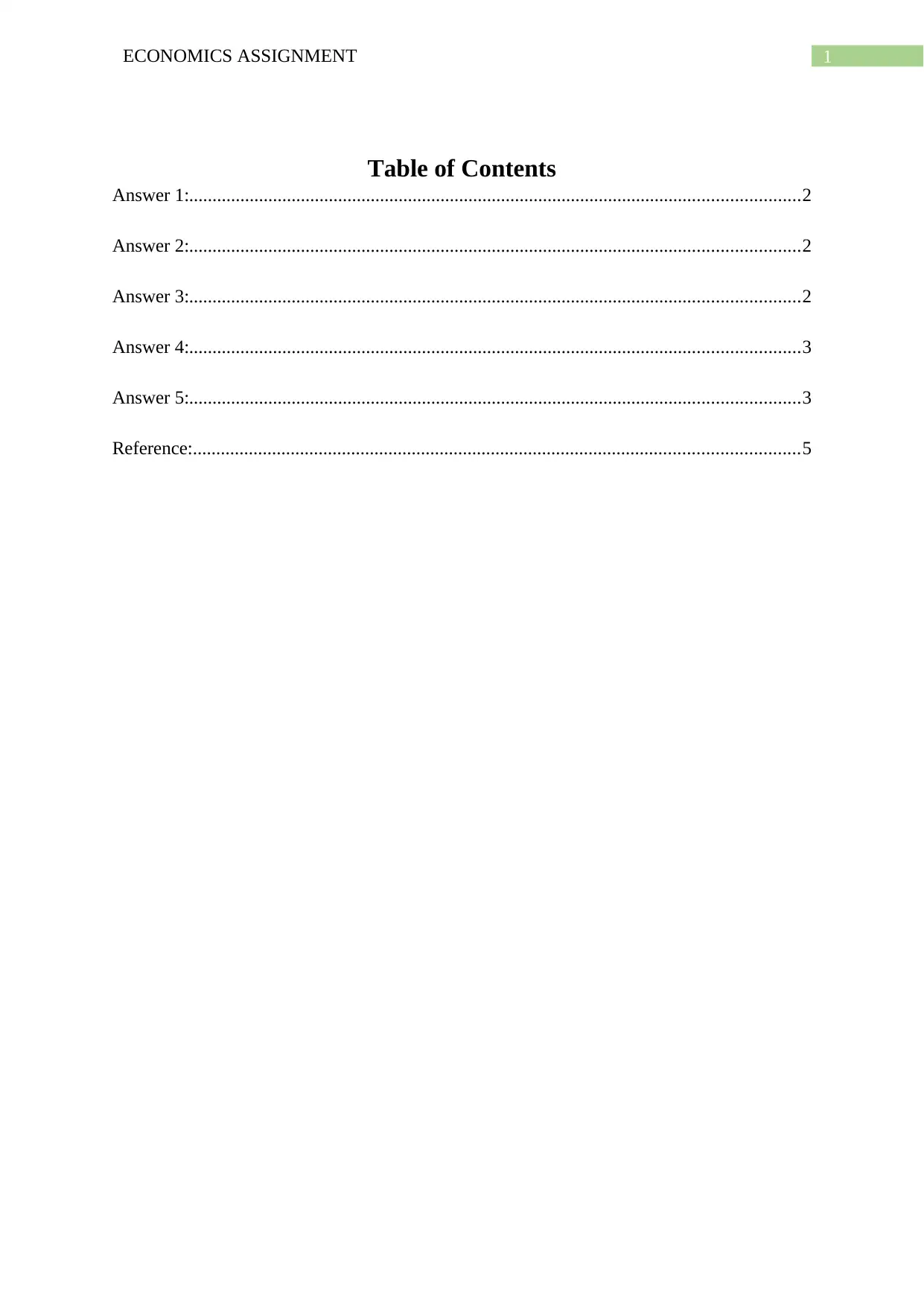
1ECONOMICS ASSIGNMENT
Table of Contents
Answer 1:...................................................................................................................................2
Answer 2:...................................................................................................................................2
Answer 3:...................................................................................................................................2
Answer 4:...................................................................................................................................3
Answer 5:...................................................................................................................................3
Reference:..................................................................................................................................5
Table of Contents
Answer 1:...................................................................................................................................2
Answer 2:...................................................................................................................................2
Answer 3:...................................................................................................................................2
Answer 4:...................................................................................................................................3
Answer 5:...................................................................................................................................3
Reference:..................................................................................................................................5
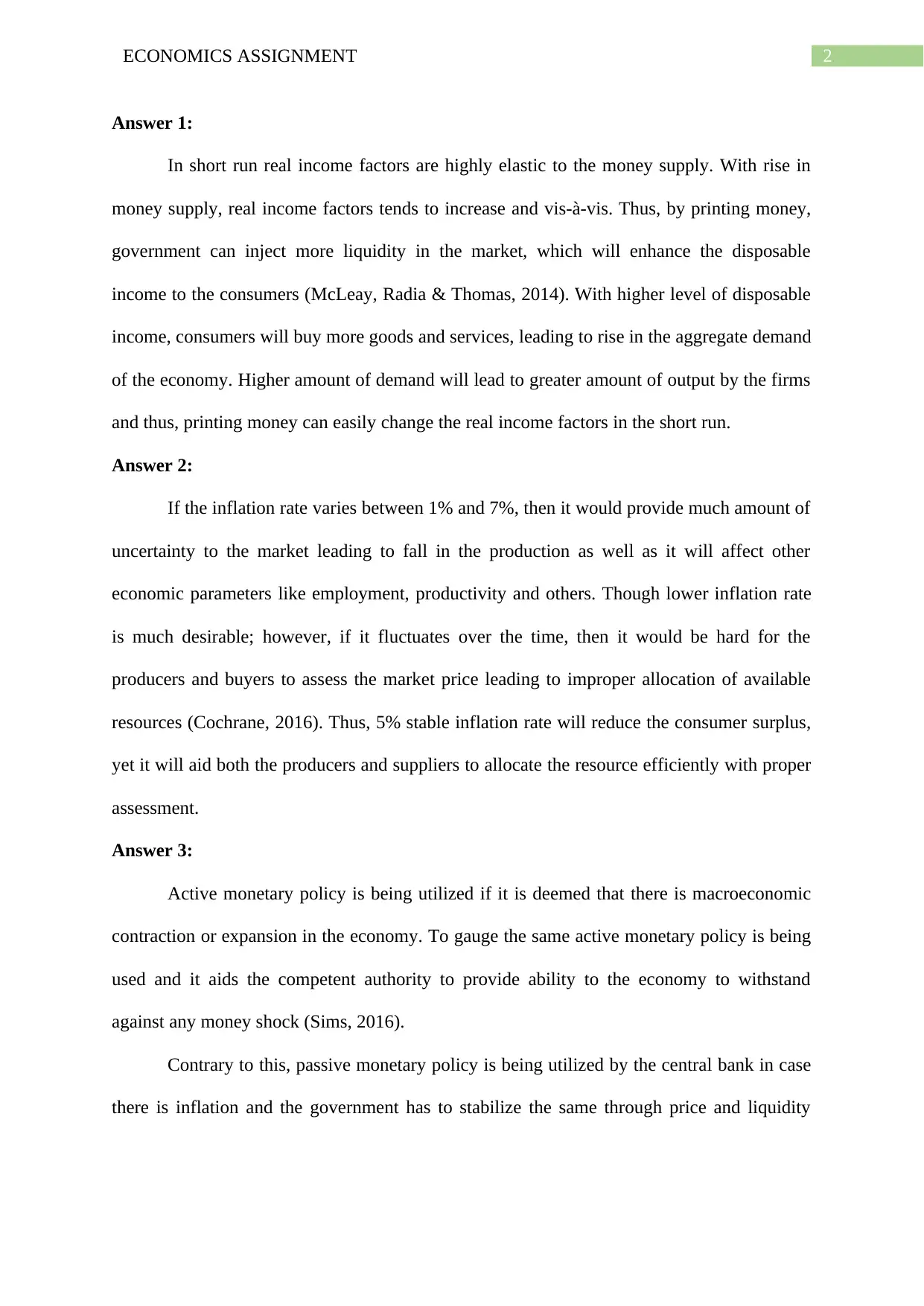
2ECONOMICS ASSIGNMENT
Answer 1:
In short run real income factors are highly elastic to the money supply. With rise in
money supply, real income factors tends to increase and vis-à-vis. Thus, by printing money,
government can inject more liquidity in the market, which will enhance the disposable
income to the consumers (McLeay, Radia & Thomas, 2014). With higher level of disposable
income, consumers will buy more goods and services, leading to rise in the aggregate demand
of the economy. Higher amount of demand will lead to greater amount of output by the firms
and thus, printing money can easily change the real income factors in the short run.
Answer 2:
If the inflation rate varies between 1% and 7%, then it would provide much amount of
uncertainty to the market leading to fall in the production as well as it will affect other
economic parameters like employment, productivity and others. Though lower inflation rate
is much desirable; however, if it fluctuates over the time, then it would be hard for the
producers and buyers to assess the market price leading to improper allocation of available
resources (Cochrane, 2016). Thus, 5% stable inflation rate will reduce the consumer surplus,
yet it will aid both the producers and suppliers to allocate the resource efficiently with proper
assessment.
Answer 3:
Active monetary policy is being utilized if it is deemed that there is macroeconomic
contraction or expansion in the economy. To gauge the same active monetary policy is being
used and it aids the competent authority to provide ability to the economy to withstand
against any money shock (Sims, 2016).
Contrary to this, passive monetary policy is being utilized by the central bank in case
there is inflation and the government has to stabilize the same through price and liquidity
Answer 1:
In short run real income factors are highly elastic to the money supply. With rise in
money supply, real income factors tends to increase and vis-à-vis. Thus, by printing money,
government can inject more liquidity in the market, which will enhance the disposable
income to the consumers (McLeay, Radia & Thomas, 2014). With higher level of disposable
income, consumers will buy more goods and services, leading to rise in the aggregate demand
of the economy. Higher amount of demand will lead to greater amount of output by the firms
and thus, printing money can easily change the real income factors in the short run.
Answer 2:
If the inflation rate varies between 1% and 7%, then it would provide much amount of
uncertainty to the market leading to fall in the production as well as it will affect other
economic parameters like employment, productivity and others. Though lower inflation rate
is much desirable; however, if it fluctuates over the time, then it would be hard for the
producers and buyers to assess the market price leading to improper allocation of available
resources (Cochrane, 2016). Thus, 5% stable inflation rate will reduce the consumer surplus,
yet it will aid both the producers and suppliers to allocate the resource efficiently with proper
assessment.
Answer 3:
Active monetary policy is being utilized if it is deemed that there is macroeconomic
contraction or expansion in the economy. To gauge the same active monetary policy is being
used and it aids the competent authority to provide ability to the economy to withstand
against any money shock (Sims, 2016).
Contrary to this, passive monetary policy is being utilized by the central bank in case
there is inflation and the government has to stabilize the same through price and liquidity
⊘ This is a preview!⊘
Do you want full access?
Subscribe today to unlock all pages.

Trusted by 1+ million students worldwide
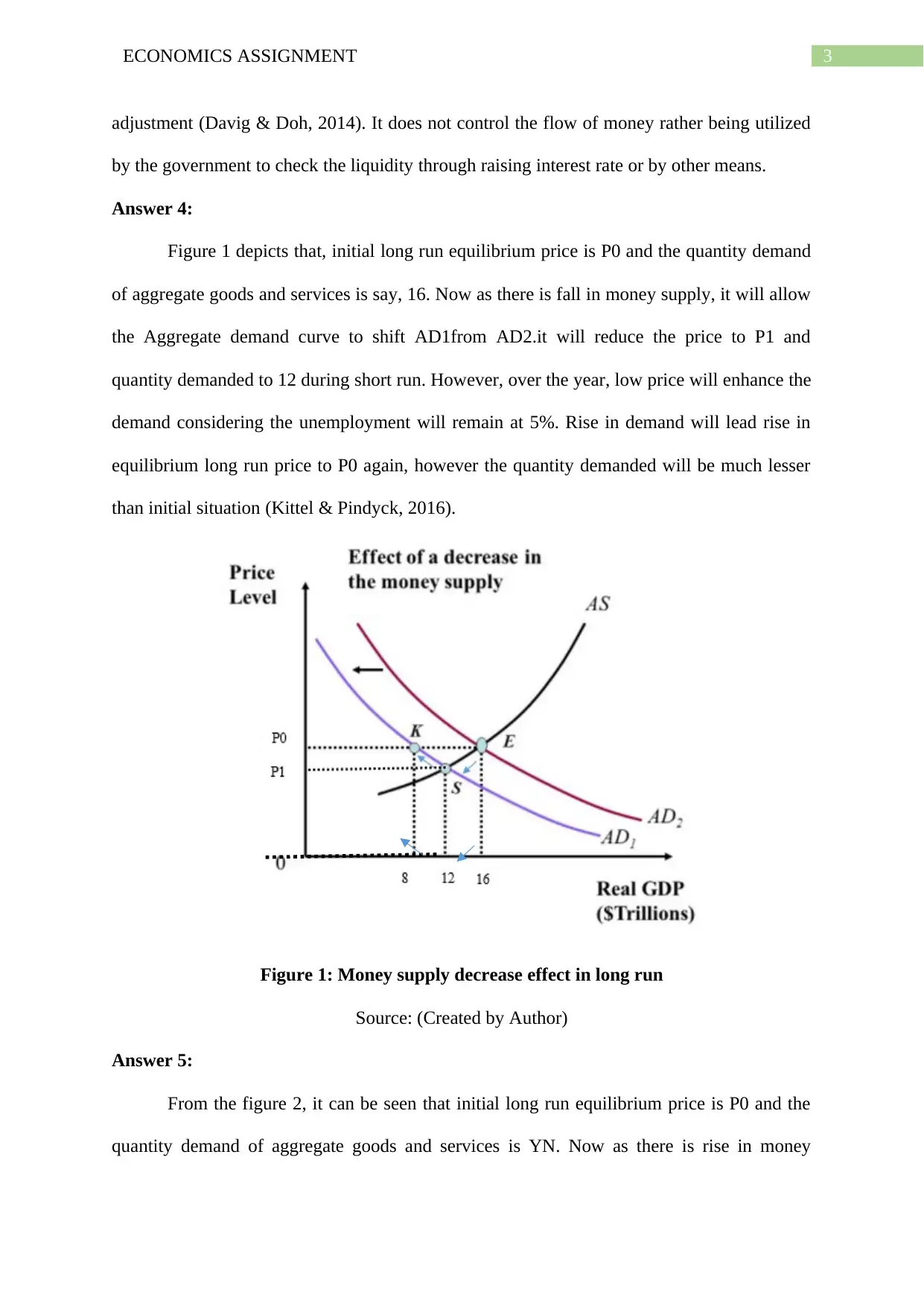
3ECONOMICS ASSIGNMENT
adjustment (Davig & Doh, 2014). It does not control the flow of money rather being utilized
by the government to check the liquidity through raising interest rate or by other means.
Answer 4:
Figure 1 depicts that, initial long run equilibrium price is P0 and the quantity demand
of aggregate goods and services is say, 16. Now as there is fall in money supply, it will allow
the Aggregate demand curve to shift AD1from AD2.it will reduce the price to P1 and
quantity demanded to 12 during short run. However, over the year, low price will enhance the
demand considering the unemployment will remain at 5%. Rise in demand will lead rise in
equilibrium long run price to P0 again, however the quantity demanded will be much lesser
than initial situation (Kittel & Pindyck, 2016).
Figure 1: Money supply decrease effect in long run
Source: (Created by Author)
Answer 5:
From the figure 2, it can be seen that initial long run equilibrium price is P0 and the
quantity demand of aggregate goods and services is YN. Now as there is rise in money
adjustment (Davig & Doh, 2014). It does not control the flow of money rather being utilized
by the government to check the liquidity through raising interest rate or by other means.
Answer 4:
Figure 1 depicts that, initial long run equilibrium price is P0 and the quantity demand
of aggregate goods and services is say, 16. Now as there is fall in money supply, it will allow
the Aggregate demand curve to shift AD1from AD2.it will reduce the price to P1 and
quantity demanded to 12 during short run. However, over the year, low price will enhance the
demand considering the unemployment will remain at 5%. Rise in demand will lead rise in
equilibrium long run price to P0 again, however the quantity demanded will be much lesser
than initial situation (Kittel & Pindyck, 2016).
Figure 1: Money supply decrease effect in long run
Source: (Created by Author)
Answer 5:
From the figure 2, it can be seen that initial long run equilibrium price is P0 and the
quantity demand of aggregate goods and services is YN. Now as there is rise in money
Paraphrase This Document
Need a fresh take? Get an instant paraphrase of this document with our AI Paraphraser
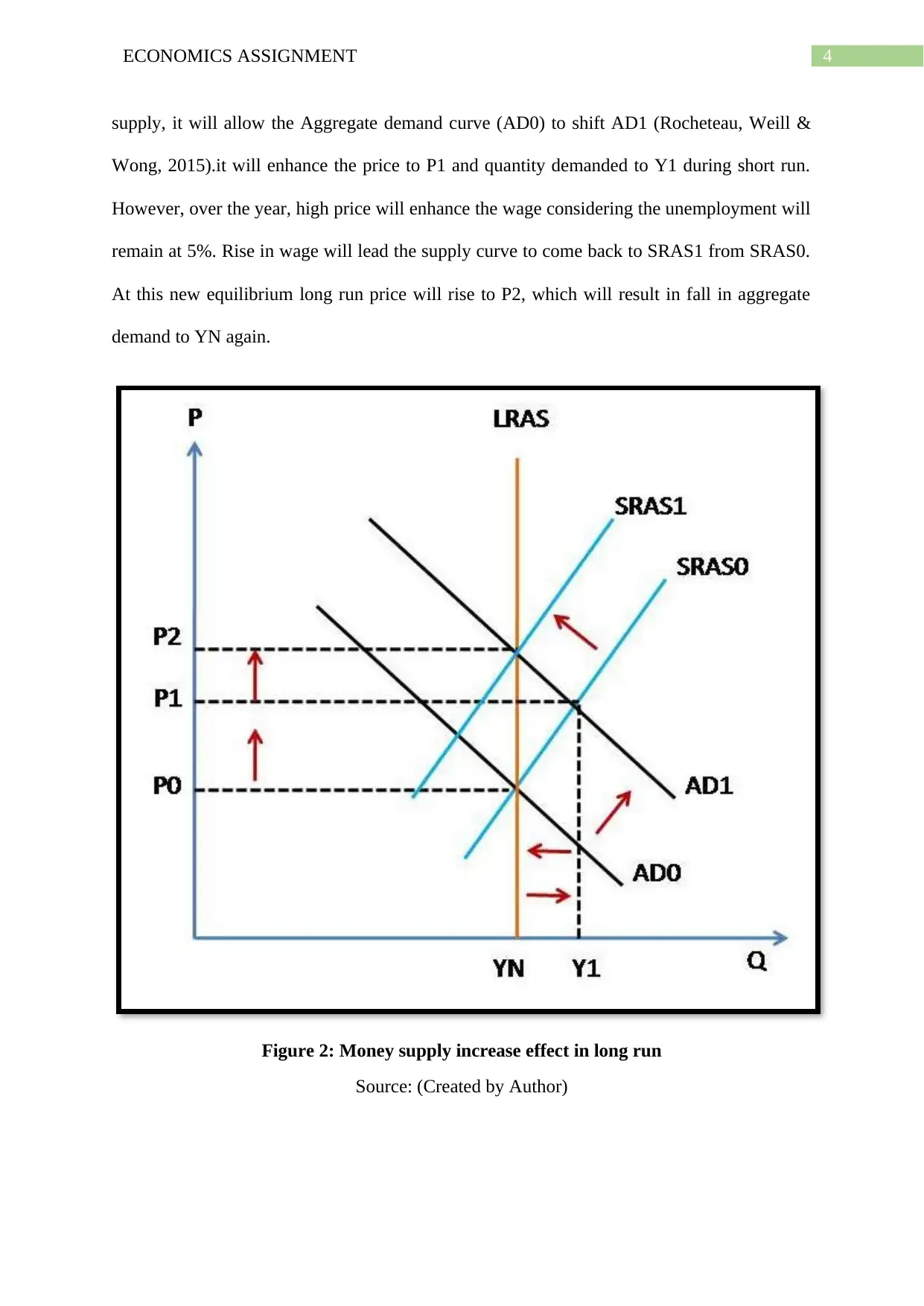
4ECONOMICS ASSIGNMENT
supply, it will allow the Aggregate demand curve (AD0) to shift AD1 (Rocheteau, Weill &
Wong, 2015).it will enhance the price to P1 and quantity demanded to Y1 during short run.
However, over the year, high price will enhance the wage considering the unemployment will
remain at 5%. Rise in wage will lead the supply curve to come back to SRAS1 from SRAS0.
At this new equilibrium long run price will rise to P2, which will result in fall in aggregate
demand to YN again.
Figure 2: Money supply increase effect in long run
Source: (Created by Author)
supply, it will allow the Aggregate demand curve (AD0) to shift AD1 (Rocheteau, Weill &
Wong, 2015).it will enhance the price to P1 and quantity demanded to Y1 during short run.
However, over the year, high price will enhance the wage considering the unemployment will
remain at 5%. Rise in wage will lead the supply curve to come back to SRAS1 from SRAS0.
At this new equilibrium long run price will rise to P2, which will result in fall in aggregate
demand to YN again.
Figure 2: Money supply increase effect in long run
Source: (Created by Author)
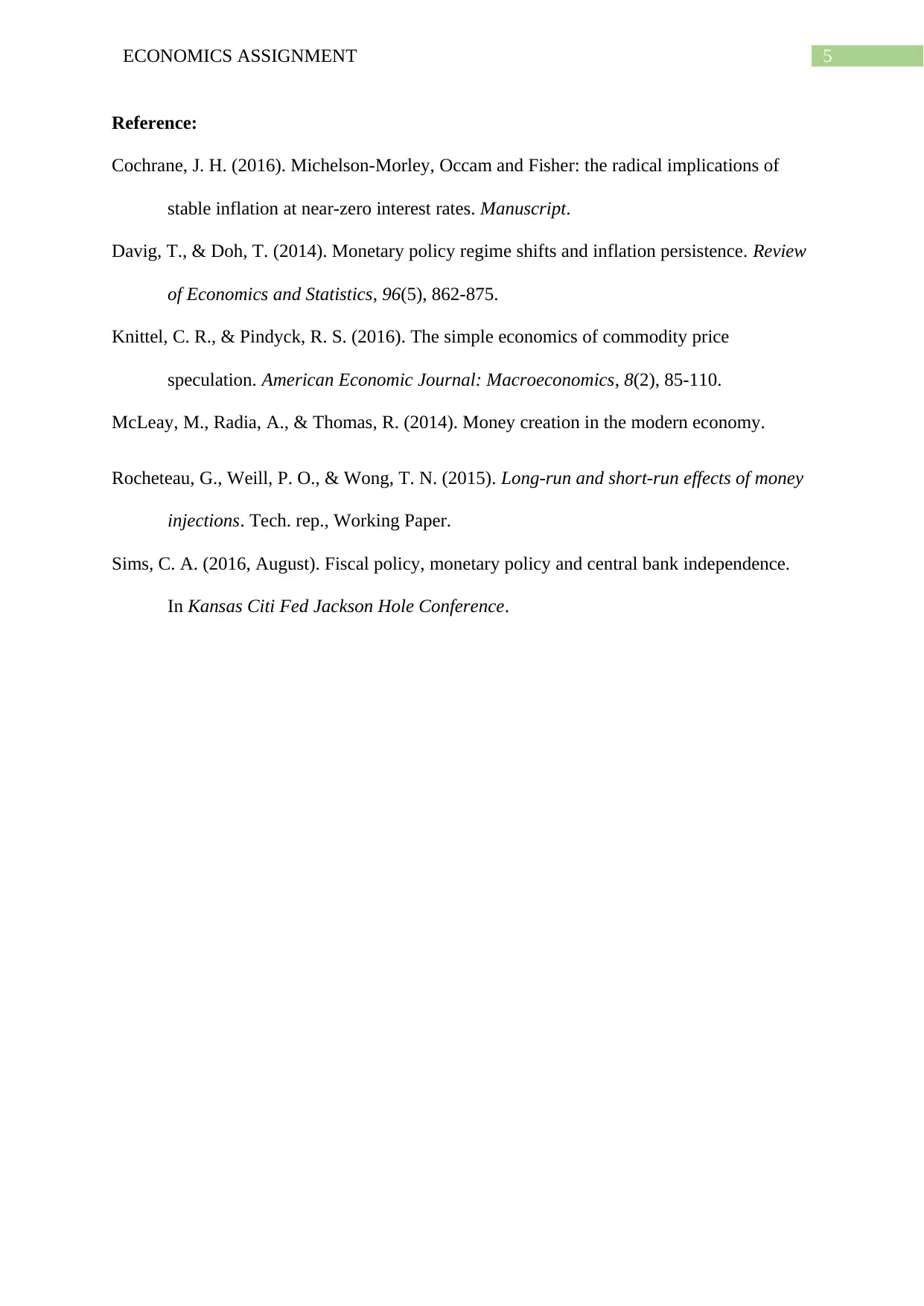
5ECONOMICS ASSIGNMENT
Reference:
Cochrane, J. H. (2016). Michelson-Morley, Occam and Fisher: the radical implications of
stable inflation at near-zero interest rates. Manuscript.
Davig, T., & Doh, T. (2014). Monetary policy regime shifts and inflation persistence. Review
of Economics and Statistics, 96(5), 862-875.
Knittel, C. R., & Pindyck, R. S. (2016). The simple economics of commodity price
speculation. American Economic Journal: Macroeconomics, 8(2), 85-110.
McLeay, M., Radia, A., & Thomas, R. (2014). Money creation in the modern economy.
Rocheteau, G., Weill, P. O., & Wong, T. N. (2015). Long-run and short-run effects of money
injections. Tech. rep., Working Paper.
Sims, C. A. (2016, August). Fiscal policy, monetary policy and central bank independence.
In Kansas Citi Fed Jackson Hole Conference.
Reference:
Cochrane, J. H. (2016). Michelson-Morley, Occam and Fisher: the radical implications of
stable inflation at near-zero interest rates. Manuscript.
Davig, T., & Doh, T. (2014). Monetary policy regime shifts and inflation persistence. Review
of Economics and Statistics, 96(5), 862-875.
Knittel, C. R., & Pindyck, R. S. (2016). The simple economics of commodity price
speculation. American Economic Journal: Macroeconomics, 8(2), 85-110.
McLeay, M., Radia, A., & Thomas, R. (2014). Money creation in the modern economy.
Rocheteau, G., Weill, P. O., & Wong, T. N. (2015). Long-run and short-run effects of money
injections. Tech. rep., Working Paper.
Sims, C. A. (2016, August). Fiscal policy, monetary policy and central bank independence.
In Kansas Citi Fed Jackson Hole Conference.
⊘ This is a preview!⊘
Do you want full access?
Subscribe today to unlock all pages.

Trusted by 1+ million students worldwide
1 out of 6
Related Documents
Your All-in-One AI-Powered Toolkit for Academic Success.
+13062052269
info@desklib.com
Available 24*7 on WhatsApp / Email
![[object Object]](/_next/static/media/star-bottom.7253800d.svg)
Unlock your academic potential
Copyright © 2020–2025 A2Z Services. All Rights Reserved. Developed and managed by ZUCOL.





